
Aloïs RevéretUiT The Arctic University of Norway · Tromsø University Museum
Aloïs Revéret
Master of Science
ECOGEN - Reconstructing Holocene polar ecosystems from sedimentary ancient DNA
About
5
Publications
1,765
Reads
How we measure 'reads'
A 'read' is counted each time someone views a publication summary (such as the title, abstract, and list of authors), clicks on a figure, or views or downloads the full-text. Learn more
17
Citations
Introduction
I study terrestrial palaeoecosystems from northern Europe and how they changed with the end of the last glaciation. I use ancient DNA from sediment cores to reconstruct past plant and mammal communities, and to infer the local conditions in which they lived. I work on a latitudinal gradient stretching from the North Cape to southernmost Norway.
Additional affiliations
Education
September 2018 - September 2020
September 2015 - August 2018
Publications
Publications (5)
Ecosystems are continuously responding to both natural and anthropogenic environmental change. Lake sediments preserve local and global evidence of these ecological transitions through time. This archived information can yield crucial insights through the reconstruction of past changes over hundreds to many thousands of years. This chapter provides...
Aquatic vegetation plays a key role in lake ecosystems, as it consists of major primary producers, fosters high biodiversity and trophic complexity, and plays a key role in freshwater biogeochemical cycles. Aquatic vegetation can be broadly divided into three taxonomic categories: macroalgae, bryophytes, and macrophytes. Macroalgae – multicellular...
Environmental DNA is increasingly being used to reconstruct past and present biodiversity including from freshwater ecosystems. Macrophytes are especially good environmental indicators, thus their environmental DNA palaeorecord might shed light on past postglacial environments.
Here, we first review and compare studies that use metagenomics, target...
En montagne, les troupeaux d'ovins, lorsqu'ils sont livrés à eux-mêmes, ont tendance à monter au cours de la journée et établissent leurs quartiers nocturnes sur des replats localisés en crêtes, dans des positions très singulières, décrites comme des invariants de l'espace : les « couchades ». Leurs sols reçoivent les déjections nocturnes du troupe...
Environmental DNA is increasingly being used to reconstruct past and present biodiversity including from freshwater ecosystems. Here, we first review and compare studies that use metagenomics, targeted capture, and various barcoding and metabarcoding markers, in order to explore how each of these methods can be used to capture aquatic vegetation di...

















